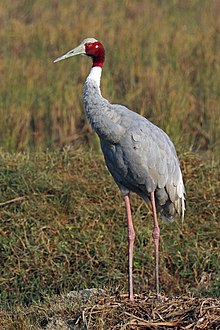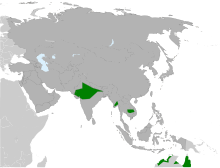
Back كركي ساروس Arabic كركى ساروس ARZ কৰ্চন চৰাই Assamese Индийски жерав Bulgarian सारस Bihari দেশি সারস Bengali/Bangla Garan Antigone Breton Grua sarus Catalan Grus antigone CEB Jeřáb Antigonin Czech
| Sarus crane | |
|---|---|

| |
| A. a. antigone from India with the distinct white "collar" | |
| Scientific classification | |
| Domain: | Eukaryota |
| Kingdom: | Animalia |
| Phylum: | Chordata |
| Class: | Aves |
| Order: | Gruiformes |
| Family: | Gruidae |
| Genus: | Antigone |
| Species: | A. antigone
|
| Binomial name | |
| Antigone antigone | |
| Subspecies | |

| |
Approximate current global distribution
| |
| Synonyms | |
| |
The sarus crane (Antigone antigone) is a large nonmigratory crane found in parts of the Indian subcontinent, Southeast Asia, and Australia. The tallest of the flying birds, standing at a height of up to 1.8 m (5 ft 11 in), they are a conspicuous species of open wetlands in South Asia, seasonally flooded Dipterocarpus forests in Southeast Asia, and Eucalyptus-dominated woodlands and grasslands in Australia.[5]
The sarus crane is easily distinguished from other cranes in the region by its overall grey colour and the contrasting red head and upper neck. They forage on marshes and shallow wetlands for roots, tubers, insects, crustaceans, and small vertebrate prey. Like other cranes, they form long-lasting pair bonds and maintain territories within which they perform territorial and courtship displays that include loud trumpeting, leaps, and dance-like movements. In India, they are considered symbols of marital fidelity, believed to mate for life and pine the loss of their mates, even to the point of starving to death.
The main breeding season is during the rainy season, when the pair builds an enormous nest "island,” a circular platform of reeds and grasses nearly two meters in diameter and high enough to stay above the shallow water surrounding it. Increased agricultural intensity is often thought to have led to declines in sarus crane numbers, but they also benefit from wetland crops and the construction of canals and reservoirs. The stronghold of the species is in India, where it is traditionally revered and lives in agricultural lands in close proximity to humans. Elsewhere, the species has been extirpated in many parts of its former range.
- ^ BirdLife International (2016). "Antigone antigone". IUCN Red List of Threatened Species. 2016: e.T22692064A93335364. doi:10.2305/IUCN.UK.2016-3.RLTS.T22692064A93335364.en. Retrieved 20 February 2022.
- ^ "Appendices | CITES". cites.org. Retrieved 14 January 2022.
- ^ Blanford, W.T (1896). "A note on the two sarus cranes of the Indian region". Ibis. 2: 135–136. doi:10.1111/j.1474-919X.1896.tb06980.x.
- ^ "Ardea antigone Linnaeus, 1758". TreatmentBank. Swiss Plazi GmbH. 2021. Retrieved 30 September 2023.
- ^ Sundar, K. S. Gopi (2019). "Species review: Sarus Crane (Grus antigone)". In Mirande, Claire M.; Harris, James T. (eds.). Crane Conservation Strategy. International Crane Foundation, Baraboo, USA. pp. 323–345.
